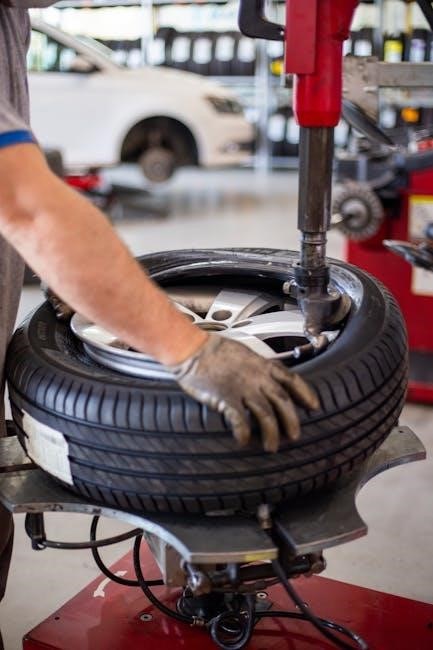Welcome to the Tire Minder Manual, your comprehensive guide to understanding and utilizing the Tire Minder system for optimal tire pressure monitoring and vehicle safety.
1.1 Purpose of the Tire Minder Manual
The purpose of the Tire Minder Manual is to provide users with a clear understanding of the system’s functionality, installation, and operation. It serves as a comprehensive guide to ensure safe and efficient use of the Tire Minder, helping users maintain optimal tire pressure and enhance vehicle performance. This manual is designed to assist both new and experienced users in troubleshooting common issues and maximizing the benefits of the system. By following the guidelines outlined, users can ensure their tires are always in the best condition, promoting safety and fuel efficiency on the road.
1;2 Audience for the Tire Minder Manual
The Tire Minder Manual is designed for vehicle owners, drivers, and enthusiasts seeking to enhance their tire monitoring capabilities. It is particularly useful for RV owners, fleet managers, and drivers of large vehicles where tire pressure monitoring is critical. The manual also caters to newcomers unfamiliar with tire pressure systems, providing a user-friendly guide to understanding and maintaining their Tire Minder. Whether for personal or professional use, this manual ensures all users can confidently operate and benefit from the Tire Minder system, regardless of their technical expertise or driving experience.

What is a Tire Minder?
A Tire Minder is an advanced tire pressure monitoring system designed to ensure optimal tire performance, safety, and efficiency for vehicles of all types.
2.1 Definition of a Tire Minder
A Tire Minder is a sophisticated monitoring system designed to track tire pressure and temperature in real-time. It consists of sensors installed on each tire and a central display unit. The system provides immediate alerts for pressure drops or abnormal temperature rises, ensuring vehicle safety and performance. By maintaining optimal tire conditions, it enhances fuel efficiency, reduces wear, and prevents potential accidents. This user-friendly technology is essential for drivers seeking to optimize their vehicle’s reliability and longevity on the road.
2.2 How a Tire Minder Works
A Tire Minder operates by utilizing sensors installed on each tire to continuously monitor pressure and temperature. These sensors transmit real-time data wirelessly to a central monitor. The system alerts drivers of pressure drops or temperature spikes, ensuring timely interventions. It enhances safety by preventing blowouts and optimizes fuel efficiency through proper tire inflation. The monitor displays data, enabling drivers to maintain ideal tire conditions and reduce wear. This system is essential for improving vehicle performance and ensuring safe driving experiences.
2.3 Benefits of Using a Tire Minder
Using a Tire Minder offers numerous benefits, including enhanced safety by preventing tire blowouts and improving vehicle stability. It promotes fuel efficiency by ensuring optimal tire pressure, reducing wear and tear. Regular monitoring extends tire lifespan and lowers maintenance costs. The system provides real-time alerts, enabling prompt action to address issues. It also contributes to better vehicle performance and handling, making driving more comfortable and secure. Overall, a Tire Minder is a practical investment for drivers seeking to maximize safety, efficiency, and convenience on the road.

Components of a Tire Minder System
A Tire Minder System includes a monitor/display unit, tire pressure sensors, and valve caps/transmitters. These components work together to monitor and display real-time tire pressure data accurately.
3.1 Monitor or Display Unit
The monitor or display unit is the central component of the Tire Minder System, providing real-time tire pressure and temperature data. It features an LCD screen that shows pressure readings for each tire, along with customizable alerts for low pressure, high temperature, or system errors. The unit is typically mounted on the dashboard for easy visibility and may include features like backlighting for night driving. Some advanced models offer touchscreen functionality, allowing users to adjust settings or view historical data. The monitor communicates wirelessly with tire sensors, ensuring seamless and accurate updates. Regular software updates may be required to maintain optimal performance.
3.2 Tire Pressure Sensors
Tire pressure sensors are small devices attached to each tire’s valve stem, continuously monitoring pressure and temperature. These sensors transmit real-time data to the monitor, ensuring accurate readings. They are designed to be durable, resisting harsh weather and road conditions. Most sensors are battery-powered, with a lifespan of several years. Proper installation is crucial to avoid interference with tire performance. Sensors are typically lightweight and compact, ensuring they do not obstruct tire functionality. Regular checks are recommended to ensure optimal accuracy and reliability in monitoring tire conditions effectively.
3.3 Valve Caps and Transmitters
Valve caps and transmitters are essential components of the Tire Minder system, serving as the interface between the tire and the monitoring unit. The valve caps are installed on the tire’s valve stems, housing the transmitters that send pressure and temperature data to the monitor. They are designed to be weather-resistant and durable, ensuring reliable performance in various conditions. The transmitters are typically battery-powered and communicate wirelessly with the monitor, providing real-time updates. Proper installation and alignment of the valve caps are critical for accurate data transmission and system functionality.

Installation Guide for Tire Minder
This section provides a comprehensive guide to installing the Tire Minder system, ensuring proper setup and seamless integration with your vehicle’s tires for accurate monitoring.
4.1 Pre-Installation Checklist
Before installing the Tire Minder system, ensure the following steps are completed:
- Verify compatibility of the Tire Minder with your vehicle’s tire configuration.
- Inspect all components for damage or defects.
- Charge the monitor and sensors according to the manufacturer’s instructions.
- Ensure tires are at the recommended pressure for accurate baseline readings.
- Consult the vehicle’s manual for any specific installation requirements.
This checklist ensures a smooth and error-free installation process.
4.2 Step-by-Step Installation Process
Follow these steps to install the Tire Minder system:
- Attach the tire pressure sensors to each wheel valve stem, ensuring a snug fit.
- Mount the monitor in an easily visible location, such as the dashboard or windshield.
- Secure the monitor using the provided adhesive or mounting bracket.
- Turn on the monitor and allow it to power up completely.
- Sync each sensor with the monitor by following the on-screen instructions.
- Test the system by checking real-time pressure readings for all tires.

Refer to the manual for specific details and ensure all connections are secure.
4.3 Syncing Sensors with the Monitor
To sync the tire pressure sensors with the monitor:
- Turn on the monitor and ensure it is in “learn” or “pairing” mode;
- Press and hold the relearn button on the monitor until it confirms pairing mode.
- For each tire, press the valve cap transmitter until the monitor acknowledges the sensor.
- Repeat for all tires, ensuring each sensor is synced individually.
- Once all sensors are paired, the monitor will display real-time data for each tire.
Syncing ensures accurate monitoring and prevents sensor cross-interference. Follow the manual for specific pairing sequences.

Operating the Tire Minder System
The Tire Minder system allows users to monitor tire pressures in real-time, receive alerts for pressure changes, and ensure optimal tire conditions for safe driving.
5.1 Turning On and Off the System
To operate the Tire Minder system, locate the power button on the monitor. Press and hold it for 2-3 seconds to turn it on. The system will perform a self-test,
connecting to sensors and initializing settings. Once complete, the indicator light will turn green, signaling readiness. To turn it off, press and hold the same
button until the light turns off and the system powers down. Always ensure the system is off when not in use to conserve battery life. Regular checks
before trips are recommended to verify proper functionality. The system may also automatically turn off after prolonged inactivity to save power.
5.2 Setting Up Custom Pressure Alerts
To set custom pressure alerts, navigate to the settings menu on the Tire Minder monitor. Use the directional arrows to select “Custom Alerts” and press
the confirm button. Enter your desired high and low pressure thresholds using the on-screen keypad. Once set, the system will alert you with a visual
and audible notification whenever tire pressure falls outside these levels. This feature allows you to personalize alerts based on your vehicle type or driving
conditions. Ensure the settings align with your vehicle’s recommended tire pressure levels, as specified in the manufacturer’s guidelines.
5.3 Understanding the Display Readings
The Tire Minder monitor provides clear and concise readings for each tire, displaying pressure in PSI or kPa and temperature in degrees Fahrenheit or Celsius. The screen
shows real-time data, updating every few seconds to ensure accuracy. Each tire is represented by an icon, with numerical values below. Green indicates normal status,
while yellow or red signals a warning or critical issue. The display also shows battery levels for sensors, ensuring you’re aware of their operational status.

Maintenance and Care Tips
Regularly clean the monitor and sensors with a soft cloth and avoid harsh chemicals. Check battery levels and replace them as needed. Keep sensors dry to
prevent damage and ensure accurate readings. Update software periodically for optimal performance. Proper care extends the lifespan and reliability of your Tire Minder system.
6.1 Cleaning the Tire Minder Components
To maintain optimal performance, regularly clean your Tire Minder components. Use a soft, dry cloth to wipe the monitor and avoid harsh chemicals. For sensors, gently remove dirt with a damp cloth, ensuring no moisture enters the sensor body. Valve caps and transmitters can be cleaned with compressed air or a small, soft-bristled brush. Avoid submerging any part in water and refrain from using abrasive materials that might scratch surfaces. Regular cleaning prevents debris buildup and ensures accurate tire pressure monitoring. Always follow the manufacturer’s cleaning guidelines for best results.
6.2 Replacing Batteries in Sensors
To replace batteries in Tire Minder sensors, first ensure the vehicle is turned off and the system is disconnected. Open the sensor by unscrewing the battery compartment, typically located at the base. Remove the old battery and insert a new one, ensuring it matches the manufacturer-recommended type. Replace the compartment and tighten securely. After installation, sync the sensor with the monitor following the manual’s instructions. Proper battery replacement ensures consistent performance and accurate tire pressure readings. Always dispose of old batteries responsibly and consult the owner’s manual for specific guidance.
6.3 Updating Software or Firmware
To update the Tire Minder’s software or firmware, start by checking for updates via the manufacturer’s website or mobile app. Download the latest version and follow the on-screen instructions to transfer it to the monitor using a USB cable or wireless connection. Ensure the system is fully powered and connected before initiating the update. Once complete, restart the monitor to apply changes. Verify the update by checking the version number in the settings menu. Refer to the manual for detailed steps, and contact customer support if issues arise during the process.

Monitoring Tire Pressure with Tire Minder
This section explains how the Tire Minder system continuously tracks tire pressure, providing real-time data and alerts for pressure changes, ensuring optimal tire health and safety.
7.1 Real-Time Pressure Monitoring
The Tire Minder system provides continuous, real-time monitoring of tire pressure, updating every few seconds to ensure accurate readings. Sensors transmit data wirelessly to the monitor, displaying pressure levels for each tire. This feature allows drivers to instantly identify any deviations from recommended levels, enabling prompt adjustments. Real-time monitoring enhances safety by preventing under-inflation or over-inflation, which can lead to tire damage or blowouts. The system also alerts users to rapid pressure changes, such as those caused by punctures, ensuring timely action can be taken to maintain tire health and overall vehicle performance.
7.2 Temperature Compensation Features
The Tire Minder system incorporates advanced temperature compensation to ensure accurate tire pressure readings. Temperature fluctuations can cause pressure changes, but the system automatically adjusts for these variations. This feature is especially useful in extreme weather conditions, where tire pressure can shift significantly. By accounting for temperature changes, the Tire Minder provides precise readings, helping to maintain optimal tire pressure and improve safety. This compensation ensures consistent performance, regardless of environmental conditions, making it a reliable tool for drivers in varying climates or those traveling long distances.
7.3 Alert Systems for Pressure Loss
The Tire Minder system features an advanced alert mechanism to notify users of tire pressure loss. Customizable thresholds allow drivers to set specific pressure levels, triggering alerts when pressures drop below safe limits. Audible and visual alarms ensure immediate notification, reducing the risk of underinflation-related issues. The system continuously monitors tire pressure in real time, providing alerts even when the vehicle is stationary or in motion. This proactive approach helps prevent tire damage, improves safety, and enhances overall vehicle performance by ensuring optimal tire conditions at all times.

Troubleshooting Common Issues
Troubleshooting involves identifying and resolving system malfunctions. Start by checking sensor connections, ensuring proper installation, and verifying battery levels. Restart the monitor and sensors if issues persist. Always refer to the manual for specific error codes and solutions to restore functionality quickly and effectively, minimizing downtime and ensuring accurate tire pressure monitoring. Regular checks can prevent recurring problems, maintaining system reliability and performance over time.
8.1 Sensor Malfunction or Disconnection
If a sensor malfunctions or disconnects, start by checking the valve cap for proper installation and tightness. Ensure no debris or dirt is blocking the sensor. Next, verify the battery level in the sensor, as low power can cause disconnection. Restart both the sensor and monitor to re-establish the connection. If issues persist, clean the sensor with a soft cloth or replace it if damaged; Finally, re-sync the sensor with the monitor following the manual’s instructions to restore accurate tire pressure readings and system functionality. Always refer to the manual for specific troubleshooting steps.
8.2 Loss of Signal Between Sensors and Monitor
If the monitor loses connection with the sensors, first ensure all components are turned on and within the recommended range. Check for physical obstructions or interference from other electronic devices. Verify that the sensors are properly synced with the monitor by following the pairing process in the manual. If issues remain, restart both the sensors and monitor. Ensure the sensors are not damaged or exposed to extreme temperatures. If the problem persists, contact customer support for further assistance or potential hardware replacement. Always refer to the manual for detailed troubleshooting steps.
8.3 Incorrect Pressure Readings
If the Tire Minder displays incorrect pressure readings, check for loose or damaged sensors. Ensure the valve caps are tightly secured and free from debris; Verify that the sensors are calibrated correctly by following the manual’s calibration procedure. Extreme temperatures or uneven tire wear may also cause inaccuracies. Restart the system and allow it to recalibrate. If issues persist, reset the sensors or replace them if necessary. Always refer to the manual for specific troubleshooting steps to ensure accurate readings and optimal system performance. Regular maintenance can help prevent such issues.

Best Practices for Using Tire Minder
Adhere to the manual’s guidelines for optimal performance. Regularly inspect sensors, ensure proper installation, and maintain recommended tire pressures. This enhances safety and efficiency while minimizing errors.
9.1 Regular Checks Before and After Trips
Regular checks are essential to ensure the Tire Minder system functions accurately. Before trips, inspect sensors for damage, verify display unit operation, and confirm all tires are at recommended pressures. After trips, review pressure readings and address any alerts. Ensure sensors are securely attached and free from debris. This routine helps prevent issues and ensures reliable monitoring. Consistency in these checks enhances safety and prolongs system longevity, making it a critical part of responsible Tire Minder usage.
9.2 Optimal Placement of Sensors
Proper sensor placement is crucial for accurate tire pressure monitoring. Ensure sensors are securely attached to the valve stems, aligned straight, and not obstructed by wheel covers. Avoid exposing sensors to direct sunlight or extreme temperatures, as this may affect performance. Maintain a clear line of sight between sensors and the monitor to prevent signal interference. Tighten sensors firmly to avoid leakage and ensure consistent pressure readings. Correct placement enhances system accuracy and reliability, providing peace of mind during travel.
9.3 Using Genuine Replacement Parts
Using genuine replacement parts for your Tire Minder system ensures optimal performance and compatibility. Genuine components are specifically designed to meet the system’s specifications, guaranteeing accurate readings and reliable operation. Avoid third-party alternatives, as they may not integrate seamlessly, potentially causing malfunctions or inaccuracies. Always purchase replacement sensors, batteries, or other accessories directly from the manufacturer or authorized dealers. This ensures your Tire Minder system functions as intended, providing consistent and trustworthy tire pressure monitoring. Genuine parts also come with warranties, offering added protection and peace of mind.
The Tire Minder system enhances safety and efficiency by monitoring tire pressure in real-time. Proper use ensures optimal performance and extends tire life. Refer to the manual for guidelines.
10.1 Summary of Key Points
This manual provides a comprehensive guide to the Tire Minder system, covering its purpose, components, installation, operation, and maintenance. It outlines the benefits of real-time tire pressure monitoring, such as improved safety, fuel efficiency, and tire longevity. The document also addresses troubleshooting common issues and offers best practices for optimal system performance. By following the guidelines, users can ensure accurate monitoring, prevent potential risks, and maximize the system’s effectiveness. Regular checks and proper care are emphasized to maintain reliability and extend the lifespan of the Tire Minder components.
10.2 Final Thoughts on Tire Minder Usage
Consistent use of the Tire Minder system ensures enhanced safety, efficiency, and peace of mind for drivers. By adhering to the guidelines outlined in this manual, users can maximize the system’s benefits and enjoy improved vehicle performance. Regular monitoring and proper maintenance are key to long-term reliability. Embrace the Tire Minder as a vital tool for proactive vehicle care, and reap the rewards of optimal tire health, reduced risks, and cost savings over time. Stay informed, stay safe, and drive with confidence.